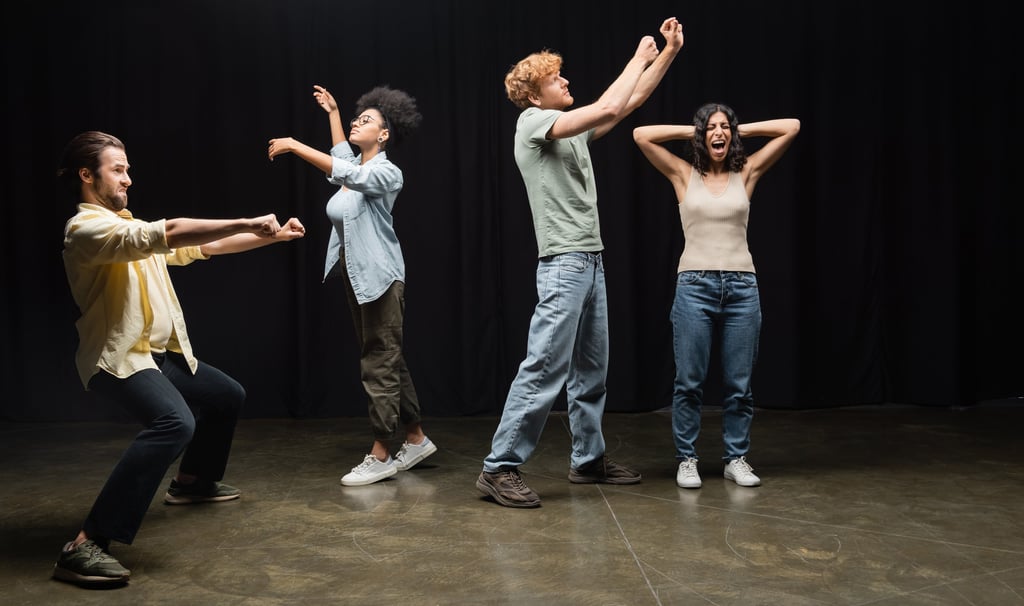New School Year, New Drama Class: Getting Buy-In from Day One by Ensemble Building
Discover how to seamlessly create ensemble building in your class or production. Our blog offers practical tips for managing diverse commitments while fostering a harmonious ensemble. Dive in to learn more!
Katie Zakkak
6/24/20253 min read


The beginning of the school year is exciting—but let’s be honest, it can also be a little daunting, especially for drama teachers.
Whether your students chose to be there or were placed in your class because they “needed an arts credit,” your goal remains the same: to create a space where students feel safe, supported, and ready to grow in confidence and communication.
In this post, I’ll share how I set the tone from day one using a beginning-of-year Ensemble Building Unit that gets students invested, engaged, and working as a team. If you’re interested, you can check out the full unit here.
Why Ensemble Building Comes First
To me, ensemble building is the foundation of everything we do in drama class. It’s how I get buy-in from students—especially those who are hesitant or unsure of what drama is all about.
Before we dive into scripts or performances, we define what ensemble even means. A lot of students think of “ensemble” as the background characters in a musical. But I help them reframe it:
An ensemble is a group of people working together toward a common goal—supporting each other, trusting each other, and relying on one another to create something bigger than themselves.
The Anti-Sabotage Contract
One of the first activities we do is create something called the Anti-Sabotage Contract.
We start by asking:
What is sabotage?
What are ways we can sabotage ourselves in this class?
What are ways we might accidentally sabotage each other?
The answers range from “being too nervous to try” to “making fun of someone who volunteers.” And that’s where we build our contract: a list of class expectations they come up with, with my guidance and final approval. Then we all sign it.
This sets the tone: drama class is a space where vulnerability is respected, not ridiculed.
✨ Want a printable, customizable version of the Anti-Sabotage Contract? It’s included in my Ensemble Building Unit here.
Bonus: Looking for a more extensive curriculum? The Ensemble Building Unit is included in my 5-Unit Curriculum Bundle. Bundle and Save 20%!
Building Trust Through Play
Once we’ve agreed to our expectations, we spend the rest of the first week (and sometimes into the second) building ensemble through games and trust activities.
These are:
Purposefully fun
Low-stakes
Focused on cooperation, focus, and play
Our goal? To get students out of their heads and into that space where creativity can actually happen. I remind them that drama class is really about play—the same kind they did as kids when someone was the mom, someone the dog, and the whole living room was a castle.
That willingness to play is the foundation for every scene, every monologue, every rehearsal to come.
From Trust to Performance
By the end of the unit, students work in mini-ensemble groups to perform something together that reflects their understanding of ensemble.
They’ve gone from defining expectations, to supporting each other in class games, to working together on a group performance that demonstrates collaboration and trust.
What I’ve found is this: starting with ensemble building directly addresses the nervous energy, hesitation, and vulnerability that come with a drama class. Even when students are excited, they need structure and support to know how to show up for each other.
And if some are unsure or resistant at first? This approach wins them over, because they feel seen, supported, and safe to take creative risks.
Want the Whole Unit Ready to Go?
If you want to start your year the same way, check out my Beginning-of-Year Ensemble Building Unit. It includes:
The Anti-Sabotage Contract (editable + printable)
Trust-building games
Performance project instructions
Day-by-day breakdowns and reflections
👉 Grab it here, and don’t forget to join my email list to get the Free Drama Teacher Toolkit.
Final Thoughts
Whether your students are future Broadway stars or drama skeptics fulfilling a requirement, you can build buy-in from day one. Set the tone, create a safe space for play, and remind them that drama is about working together toward something great.
Here’s to a fresh start, a brave ensemble, and a year full of creativity.
Happy teaching—and break a leg!

